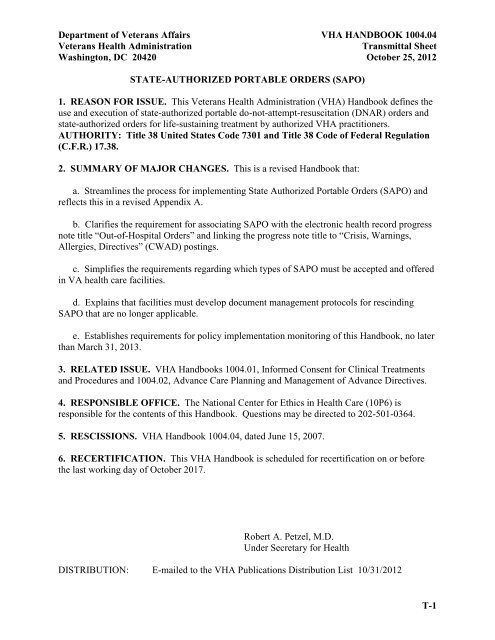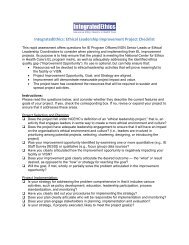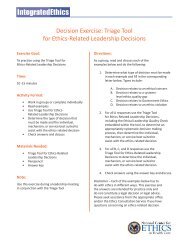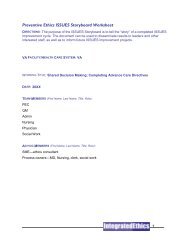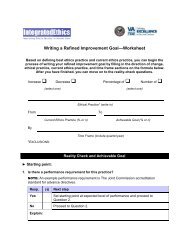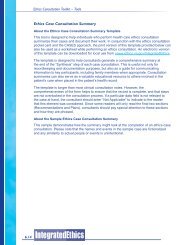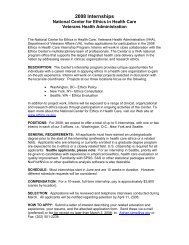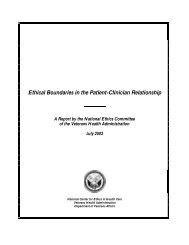VHA Handbook 1004.04, State-authorized Portable Orders (SAPO ...
VHA Handbook 1004.04, State-authorized Portable Orders (SAPO ...
VHA Handbook 1004.04, State-authorized Portable Orders (SAPO ...
You also want an ePaper? Increase the reach of your titles
YUMPU automatically turns print PDFs into web optimized ePapers that Google loves.
Department of Veterans Affairs <strong>VHA</strong> HANDBOOK <strong>1004.04</strong><br />
Veterans Health Administration<br />
Transmittal Sheet<br />
Washington, DC 20420 October 25, 2012<br />
STATE-AUTHORIZED PORTABLE ORDERS (<strong>SAPO</strong>)<br />
1. REASON FOR ISSUE. This Veterans Health Administration (<strong>VHA</strong>) <strong>Handbook</strong> defines the<br />
use and execution of state-<strong>authorized</strong> portable do-not-attempt-resuscitation (DNAR) orders and<br />
state-<strong>authorized</strong> orders for life-sustaining treatment by <strong>authorized</strong> <strong>VHA</strong> practitioners.<br />
AUTHORITY: Title 38 United <strong>State</strong>s Code 7301 and Title 38 Code of Federal Regulation<br />
(C.F.R.) 17.38.<br />
2. SUMMARY OF MAJOR CHANGES. This is a revised <strong>Handbook</strong> that:<br />
a. Streamlines the process for implementing <strong>State</strong> Authorized <strong>Portable</strong> <strong>Orders</strong> (<strong>SAPO</strong>) and<br />
reflects this in a revised Appendix A.<br />
b. Clarifies the requirement for associating <strong>SAPO</strong> with the electronic health record progress<br />
note title “Out-of-Hospital <strong>Orders</strong>” and linking the progress note title to “Crisis, Warnings,<br />
Allergies, Directives” (CWAD) postings.<br />
c. Simplifies the requirements regarding which types of <strong>SAPO</strong> must be accepted and offered<br />
in VA health care facilities.<br />
d. Explains that facilities must develop document management protocols for rescinding<br />
<strong>SAPO</strong> that are no longer applicable.<br />
e. Establishes requirements for policy implementation monitoring of this <strong>Handbook</strong>, no later<br />
than March 31, 2013.<br />
3. RELATED ISSUE. <strong>VHA</strong> <strong>Handbook</strong>s 1004.01, Informed Consent for Clinical Treatments<br />
and Procedures and 1004.02, Advance Care Planning and Management of Advance Directives.<br />
4. RESPONSIBLE OFFICE. The National Center for Ethics in Health Care (10P6) is<br />
responsible for the contents of this <strong>Handbook</strong>. Questions may be directed to 202-501-0364.<br />
5. RESCISSIONS. <strong>VHA</strong> <strong>Handbook</strong> <strong>1004.04</strong>, dated June 15, 2007.<br />
6. RECERTIFICATION. This <strong>VHA</strong> <strong>Handbook</strong> is scheduled for recertification on or before<br />
the last working day of October 2017.<br />
Robert A. Petzel, M.D.<br />
Under Secretary for Health<br />
DISTRIBUTION: E-mailed to the <strong>VHA</strong> Publications Distribution List 10/31/2012<br />
T-1
October 25, 2012 <strong>VHA</strong> HANDBOOK <strong>1004.04</strong><br />
CONTENTS<br />
STATE-AUTHORIZED PORTABLE ORDERS (<strong>SAPO</strong>)<br />
PARAGRAPH<br />
PAGE<br />
1. Purpose ...................................................................................................................................... 1<br />
2. Background ............................................................................................................................... 1<br />
3. Definitions ................................................................................................................................. 1<br />
4. Scope ......................................................................................................................................... 3<br />
5. Procedures for the Implementation of Veterans’ <strong>SAPO</strong> by <strong>VHA</strong> ............................................ 3<br />
6. Documentation of the Implementation of Veterans’ <strong>SAPO</strong> by <strong>VHA</strong> ....................................... 4<br />
7. Procedures for Offering and Writing <strong>SAPO</strong> for <strong>VHA</strong> Patients as Part of Outpatient or Home<br />
Care or at Discharge ............................................................................................................. 5<br />
8. Documentation of the Offering and Writing of <strong>SAPO</strong> for <strong>VHA</strong> Patients as Part of Outpatient<br />
or Home Care or at Discharge ............................................................................................. 6<br />
9. Responsibilities of the Deputy Under Secretary for Health for Operations and Management . 6<br />
10. Responsibilities of the National Center for Ethics in Health Care ......................................... 6<br />
11. Responsibilities of the Facility Director ................................................................................. 6<br />
12. Responsibilities of the Facility Chief of Staff ......................................................................... 7<br />
13. Responsibilities of the Facility Office of Health Information and Technology<br />
Representative or CWAD Manager ..................................................................................... 7<br />
14. Reference ................................................................................................................................ 7<br />
APPENDIX<br />
A The <strong>State</strong>-Authorized <strong>Portable</strong> <strong>Orders</strong> (<strong>SAPO</strong>) Process ...................................................... A-1<br />
i
October 25, 2012 <strong>VHA</strong> HANDBOOK <strong>1004.04</strong><br />
1. PURPOSE<br />
STATE-AUTHORIZED PORTABLE ORDERS (<strong>SAPO</strong>)<br />
This Veterans Health Administration (<strong>VHA</strong>) <strong>Handbook</strong> defines the use and execution of<br />
state-<strong>authorized</strong> portable do-not-attempt-resuscitation (DNAR) orders and state-<strong>authorized</strong><br />
orders for life-sustaining treatment by <strong>authorized</strong> <strong>VHA</strong> practitioners. AUTHORITY: Title 38<br />
United <strong>State</strong>s Code 7301 and Title 38 Code of Federal Regulation (C.F.R.) 17.38.<br />
2. BACKGROUND<br />
a. Patients have expressed concern that their documented life-sustaining treatment<br />
preferences may be ignored in emergency situations. In response, the majority of the fifty states<br />
have developed protocols that translate a patient’s preferences regarding interventions, such as<br />
resuscitation, mechanical ventilation, or the provision of artificial nutrition and hydration into<br />
portable doctor’s orders. As a generally accepted standard of medical practice, <strong>State</strong> Authorized<br />
<strong>Portable</strong> <strong>Orders</strong> (<strong>SAPO</strong>) are communicated to first responders (e.g., ambulance personnel) and<br />
clinicians through specialized forms, such as Oregon’s Physician <strong>Orders</strong> for Life-Sustaining<br />
Treatment (POLST), or state-<strong>authorized</strong> identifiers, such as a state-<strong>authorized</strong> Do Not Attempt<br />
Resuscitation (DNAR) bracelet.<br />
b. By legitimizing and standardizing these protocols, states are promoting community-wide<br />
use and practitioner adherence in order to ensure that a patient’s <strong>SAPO</strong> status is respected by<br />
emergency medical service providers and receiving health care facilities.<br />
c. Section 17.38 of title 38 Code of Federal Regulations (CFR) establishes that care must be<br />
provided by the Department of Veterans Affairs (VA) to individuals in accordance with<br />
generally accepted standards of medical practice.<br />
d. In keeping with this authority and VA’s commitment to promoting patient-centered care<br />
and ensuring that Veterans values, goals, and treatment preferences are respected and reflected in<br />
the care they receive, <strong>VHA</strong> supports the use of <strong>SAPO</strong>.<br />
3. DEFINITIONS<br />
a. Cardiopulmonary Resuscitation (CPR). CPR is the use of Basic Life Support and<br />
Advanced Cardiac Life Support (a) in an attempt to restore spontaneous circulation following<br />
cardiopulmonary arrest (i.e., the loss of airway, breathing, or circulation necessary to maintain<br />
life). CPR is a life-sustaining treatment. As used in this <strong>Handbook</strong>, the term “resuscitation” is<br />
synonymous with the terms “cardiopulmonary resuscitation” and “CPR.”<br />
b. Decision-Making Capacity. Decision-making capacity is a clinical judgment about a<br />
patient’s ability to make a particular type of health care decision at a particular time. In clinical<br />
practice, a patient’s decision-making capacity is generally presumed; however, when the<br />
patient’s medical condition or observed behavior raises questions about the patient’s decisionmaking<br />
capacity, the responsible practitioner must make an explicit determination by assessing<br />
the patient’s ability to do all of the following:<br />
1
<strong>VHA</strong> HANDBOOK <strong>1004.04</strong> October 25, 2012<br />
(1) Communicate a choice;<br />
(2) Understand the relevant information;<br />
(3) Appreciate the situation and its consequences; and<br />
(4) Reason about treatment options.<br />
NOTE: In contrast, “competence” is a legal determination made by a court of law (see <strong>VHA</strong><br />
<strong>Handbook</strong> 1004.01).<br />
c. Do Not Attempt Resuscitation (DNAR) Order. A DNAR order is an order that<br />
establishes that CPR must not be attempted for a patient in cardiopulmonary arrest (i.e., the loss<br />
of airway, breathing, or circulation necessary to maintain life). Patients with a DNAR order<br />
must still receive clinically appropriate emergency interventions short of CPR (for example<br />
medications, fluids, oxygen, manual removal of an airway obstruction or the Heimlich<br />
maneuver). NOTE: The terms DNR, No-CPR, and No Code are synonymous with DNAR.<br />
DNAR is the preferred term in <strong>VHA</strong>.<br />
d. Life-Sustaining Treatment (LST). A LST is a medical treatment that is administered in<br />
an attempt to prolong the life of a patient who would be expected to die soon without the<br />
treatment.<br />
e. Medical Emergency. For the purposes of this <strong>Handbook</strong>, a medical emergency refers to<br />
a situation in which immediate medical care is necessary to preserve the patient’s life or avert<br />
serious impairment to the patient’s health and the practitioner determines that delaying medical care<br />
in order to discuss the <strong>SAPO</strong> with the patient or patient’s surrogate (if applicable) would increase the<br />
hazard to the life or health of the patient.<br />
f. <strong>State</strong>-Authorized <strong>Portable</strong> <strong>Orders</strong> (<strong>SAPO</strong>). <strong>SAPO</strong>’s are specialized forms or identifiers<br />
(e.g., DNAR bracelets or necklaces) <strong>authorized</strong> by state law, that translate a patient’s preferences<br />
with regard to specific life-sustaining treatment decisions into portable medical orders. <strong>Portable</strong><br />
orders are designed to be easily recognizable and understood by first responders and other health<br />
care personnel and to travel with the patient whenever the patient is transported to or from a<br />
health care facility. Examples of <strong>SAPO</strong> forms include; Oregon’s Physician <strong>Orders</strong> for Life-<br />
Sustaining Treatment (POLST); West Virginia’s Physician <strong>Orders</strong> for Scope of Treatment<br />
(POST); New York’s Medical <strong>Orders</strong> for Life Sustaining Treatment (MOLST); and out-ofhospital<br />
DNAR orders (e.g., New York <strong>State</strong>’s Out-of-Hospital DNR order form).<br />
g. Surrogate Decision Maker (Surrogate). A Surrogate refers to an individual <strong>authorized</strong><br />
under <strong>VHA</strong> policy to make health care decisions on behalf of a patient who lacks decisionmaking<br />
capacity. NOTE: For more information see <strong>VHA</strong> <strong>Handbook</strong> 1004.01, Informed Consent<br />
for Clinical Treatments and Procedures for information about surrogate selection, hierarchy,<br />
and the surrogate’s role in health care decision making.<br />
2
October 25, 2012 <strong>VHA</strong> HANDBOOK <strong>1004.04</strong><br />
4. SCOPE<br />
This <strong>Handbook</strong> requires that Veterans’ <strong>SAPO</strong> for DNAR and life-sustaining treatment are<br />
recognized by <strong>VHA</strong>, and that <strong>authorized</strong> <strong>VHA</strong> practitioners write such orders to the extent<br />
permissible by <strong>VHA</strong> policy, and state and Federal law.<br />
5. PROCEDURES FOR IMPLEMENTATION OF VETERANS’ <strong>SAPO</strong> BY <strong>VHA</strong><br />
When a Veteran presents to a <strong>VHA</strong> facility with <strong>SAPO</strong>, <strong>VHA</strong> practitioners must adhere to<br />
the following procedures: NOTE: See flowchart in Appendix A for more information.<br />
a. In a medical emergency, the <strong>VHA</strong> practitioner must:<br />
(1) Act in accordance with the Veteran’s <strong>SAPO</strong>, unless there is a reason to doubt their<br />
validity, such as, the form or identifier is inconsistent with known state requirements, required<br />
signatures are missing, the form or identifier has clearly been tampered with, or the Veteran<br />
indicates by unambiguous verbal or non-verbal instructions that the order is to be rescinded (as<br />
the current wishes of the competent patients have priority).<br />
(2) Write orders that correspond to the <strong>SAPO</strong>. NOTE: <strong>VHA</strong> practitioners may only write<br />
such orders as they are otherwise <strong>authorized</strong> to write under <strong>VHA</strong> policy and Federal law.<br />
(3) Document the relevant instructions in the patient’s treatment plan for any instruction on a<br />
patient’s <strong>SAPO</strong> that would not normally be entered as an order. An example of this would be an<br />
instruction for a time-limited trial of mechanical ventilation.<br />
b. Once the patient has been stabilized to the extent that there is no longer a medical<br />
emergency, practitioners must, at the earliest reasonable opportunity, confirm the orders with the<br />
Veteran or surrogate, depending on the Veteran’s decision-making capacity, as follows: NOTE:<br />
Patients are presumed to have decision-making capacity. However, if the patient’s medical<br />
condition or observed behavior raises questions about the patient’s decision-making capacity,<br />
the practitioner must perform (or obtain) and document a clinical assessment of decision-making<br />
capacity. See <strong>VHA</strong> <strong>Handbook</strong> 1004.01, Informed Consent for Clinical Treatments and<br />
Procedures for information about assessment of decision-making capacity.<br />
(1) If the Veteran has decision-making capacity, the practitioner must conduct a discussion<br />
with the patient to review their values and preferences, discuss goals of care, recommend a<br />
specific treatment plan to achieve agreed-upon goals, obtain informed consent for the plan, and<br />
implement the plan by writing specific <strong>VHA</strong> orders consistent with the patient’s wishes<br />
according to applicable <strong>VHA</strong> policy, including appropriate documentation procedures as<br />
indicated in <strong>VHA</strong> <strong>Handbook</strong> 1004.3, Do Not Resuscitate (DNR) Protocols Within the<br />
Department of Veterans Affairs (VA), and <strong>VHA</strong> <strong>Handbook</strong> 1004.01, Informed Consent for<br />
Clinical Treatments and Procedures.<br />
(2) If the Veteran does not have decision-making capacity, the practitioner must determine<br />
whether the Veteran also has a valid advance directive(s) and follow the procedures outlined<br />
3
<strong>VHA</strong> HANDBOOK <strong>1004.04</strong> October 25, 2012<br />
below: NOTE: These steps are consistent with the steps outlined in <strong>VHA</strong> <strong>Handbook</strong> 1004.02,<br />
Advance Care Planning and Management of Advance Directives, paragraph 13 for<br />
implementing a patient’s advance directive(s).<br />
(a) Consult with the surrogate to determine whether the Veteran also has a valid advance<br />
directive(s). If a patient has both <strong>SAPO</strong> and one or more valid advance directive (e.g., a VA<br />
advance directive and a <strong>State</strong>-<strong>authorized</strong> advance directive), all apply. For any inconsistent or<br />
overlapping elements, the information in the document with the most recent date generally<br />
supersedes the information in the prior document unless there is sufficient reason to conclude<br />
that the more recent information does not actually reflect the patient’s current preferences.<br />
NOTE: Practitioners may wish to consult Regional Counsel or the facility Ethics Consultation<br />
Service to make a determination about specific cases in which the patient lacks decision-making<br />
capacity and the <strong>SAPO</strong> and advance directive are inconsistent. See <strong>VHA</strong> <strong>Handbook</strong> 1004.01,<br />
Informed Consent for Clinical Treatments and Procedures, for procedures regarding informed<br />
consent for patients who lack decision making capacity.<br />
4<br />
(b) Personally and in their entirety read all applicable <strong>SAPO</strong> and advance directive(s).<br />
(c) Ensure that the relevant clinical criteria described in the applicable <strong>SAPO</strong> and advance<br />
directive(s) are met.<br />
(d) Identify the <strong>authorized</strong> surrogate decision maker.<br />
(e) Consult with the surrogate and develop a treatment plan based on the applicable <strong>SAPO</strong><br />
and advance directive(s).<br />
6. DOCUMENTATION OF THE IMPLEMENTATION OF VETERANS’ <strong>SAPO</strong> BY <strong>VHA</strong><br />
When a Veteran presents with <strong>SAPO</strong> to a <strong>VHA</strong> facility, <strong>VHA</strong> practitioners must adhere to<br />
the following documentation procedures: NOTE: See flowchart in Appendix A for more<br />
information.<br />
a. Write a progress note indicating that the Veteran presented with an <strong>authorized</strong> identifier<br />
(e.g., bracelet or necklace) or paper orders (e.g., POLST). Specify the date and jurisdiction of<br />
the <strong>SAPO</strong>, and a description of the substance of the <strong>SAPO</strong>, describing the relevant orders. The<br />
progress note for a current <strong>SAPO</strong> must be associated with the electronic health record note title<br />
“Out-of-Hospital <strong>Orders</strong>.” No other note title or variation on this note title may be used for a<br />
current <strong>SAPO</strong>.<br />
b. If the Veteran presents with a paper <strong>SAPO</strong>, practitioners must have the paper <strong>SAPO</strong><br />
promptly scanned into the Veteran’s electronic health record with an associated progress note<br />
titled “Out-of-Hospital <strong>Orders</strong>.” The original paper document must be returned to the Veteran or<br />
surrogate decision maker. NOTE: Scanned <strong>SAPO</strong> are not VA orders.<br />
c. For <strong>SAPO</strong> that are no longer applicable, facilities must develop their own document<br />
management protocols for rescinding these non-current orders. This may include the use of a<br />
note title such as “Out-of-Hospital <strong>Orders</strong>: Rescinded.”
October 25, 2012 <strong>VHA</strong> HANDBOOK <strong>1004.04</strong><br />
d. Writing, when appropriate, a <strong>VHA</strong> DNAR order in a medical emergency on the basis of<br />
the Veteran’s <strong>SAPO</strong> represents an exception to the documentation requirements of <strong>VHA</strong><br />
<strong>Handbook</strong> 1004.3, Do not Resuscitate (DNR) Protocols within the Department of Veterans<br />
Affairs. That is, in order to honor and facilitate the portability of valid <strong>SAPO</strong>, the practitioner is<br />
not required, when writing a <strong>VHA</strong> DNAR and progress note in a medical emergency on the basis<br />
of a patient’s <strong>SAPO</strong>, to document diagnosis and prognosis, consensual decisions and<br />
recommendations, assessment of the Veteran’s decision-making capacity, or Veteran wishes as<br />
outlined in <strong>VHA</strong> <strong>Handbook</strong> 1004.3.<br />
e. All other orders must be documented in a manner consistent with <strong>VHA</strong> documentation<br />
protocols (see <strong>VHA</strong> <strong>Handbook</strong> 1907.01, Health Information Management and Health Records).<br />
7. PROCEDURES FOR THE OFFERING AND WRITING <strong>SAPO</strong> FOR <strong>VHA</strong> PATIENTS<br />
AS PART OF OUTPATIENT OR HOME CARE OR AT DISCHARGE<br />
a. <strong>SAPO</strong> are valid outside of <strong>VHA</strong> facilities. Therefore, such orders may only be written by<br />
<strong>VHA</strong> practitioners who are <strong>authorized</strong> under both state law and <strong>VHA</strong> policy to write such orders.<br />
If a practitioner determines that <strong>SAPO</strong> are appropriate, but does not have authority to write them,<br />
the practitioner must follow locally established procedures (see subpar. 11c) for identifying the<br />
appropriate practitioner to write the orders. Regardless of state law, practitioners who are not<br />
<strong>authorized</strong> within <strong>VHA</strong> to write DNAR orders are not permitted to write <strong>SAPO</strong> while<br />
functioning in their <strong>VHA</strong> capacity.<br />
b. If a state within the facility’s catchment area authorizes the use of <strong>SAPO</strong>, <strong>VHA</strong><br />
practitioners must give Veterans the opportunity to have such orders written or revised as part of<br />
the discharge planning process from a <strong>VHA</strong> facility and, when appropriate, as part of out-patient<br />
or home care. These orders must be based on a discussion with the Veteran or, as appropriate,<br />
the Veteran’s surrogate decision maker, regarding the Veteran’s current diagnosis, condition,<br />
values and preferences, goals of care, and specific treatment plan.<br />
c. These orders must be offered, written, or revised under the following circumstances:<br />
(1) As appropriate to the Veteran’s medical condition and preferences, <strong>authorized</strong><br />
practitioners must write <strong>SAPO</strong> when <strong>SAPO</strong> are requested by a Veteran or the Veteran’s<br />
surrogate.<br />
(2) As part of discharge planning for Veterans who have presented with existing <strong>SAPO</strong>,<br />
practitioners must discuss with the Veteran or surrogate whether the orders is to remain as-is or<br />
whether revisions are needed. If revisions are needed and desired by the Veteran, the <strong>authorized</strong><br />
practitioner must provide new <strong>SAPO</strong> to the Veteran at discharge.<br />
(3) <strong>SAPO</strong> must be offered at discharge to Veterans (or their <strong>authorized</strong> surrogate) for whom<br />
a DNAR order or orders regarding life-sustaining treatment (including artificially administered<br />
nutrition and hydration and mechanical ventilation) have been written in the context of their<br />
<strong>VHA</strong> care.<br />
5
<strong>VHA</strong> HANDBOOK <strong>1004.04</strong> October 25, 2012<br />
8. DOCUMENTATION OF THE OFFERING AND WRITING <strong>SAPO</strong> FOR <strong>VHA</strong><br />
PATIENTS AS PART OF OUTPATIENT OR HOME CARE OR AT DISCHARGE<br />
When <strong>SAPO</strong> are written by a <strong>VHA</strong> provider (e.g., at discharge or as part of outpatient or<br />
home care), a copy of the completed form must be incorporated into the health record with an<br />
associated progress note titled “Out-of-Hospital <strong>Orders</strong>.” If these <strong>SAPO</strong> contain a DNAR order,<br />
the documentation requirements in <strong>Handbook</strong> 1004.3 must be followed.<br />
9. RESPONSIBILITIES OF THE DEPUTY UNDER SECRETARY FOR HEALTH FOR<br />
OPERATIONS AND MANAGEMENT<br />
The Deputy Under Secretary for Health for Operations and Management is responsible for<br />
ensuring that policy and procedures, consistent with this <strong>Handbook</strong>, are implemented in VA<br />
facilities by following up on reports of inadequate adherence with this <strong>Handbook</strong>.<br />
10. RESPONSIBILITIES OF THE NATIONAL CENTER FOR ETHICS IN HEALTH<br />
CARE<br />
6<br />
The National Center for Ethics in Health Care is responsible for:<br />
a. Providing ethics consultation services to the field regarding the policy and procedures<br />
process as outlined in this <strong>Handbook</strong>.<br />
b. Annually and as needed, establishing policy implementation monitoring criteria for this<br />
<strong>Handbook</strong>, collecting VA facility data on policy implementation monitoring, and providing data<br />
to the Deputy Under Secretary for Health for Operations and Management.<br />
11. RESPONSIBILITIES OF THE FACILITY DIRECTOR<br />
The facility Director is responsible for:<br />
a. Ensuring that local policy and procedures, consistent with this <strong>Handbook</strong>, are developed,<br />
published, and implemented, no later than March 31, 2013.<br />
b. Consulting with Regional Counsel to develop local policy and procedures on <strong>SAPO</strong>,<br />
including determination and identification in policy of the categories of practitioners <strong>authorized</strong><br />
under state law and <strong>VHA</strong> scope of practice or clinical privileges to write <strong>SAPO</strong> for use outside<br />
of <strong>VHA</strong> facilities. NOTE: Because state laws vary regarding the forms or identifiers that may<br />
be recognized and the categories of professional who may write <strong>SAPO</strong>, it is essential that facility<br />
staff consult with Regional Counsel before developing facility-based policy and procedures.<br />
c. Developing protocols identifying who will write <strong>SAPO</strong> when the practitioner responsible<br />
for the Veteran’s care is not <strong>authorized</strong> to write the order under state law or their <strong>VHA</strong> scope of<br />
practice or clinical privileges.<br />
d. Ensuring a document management protocol for entering and managing <strong>SAPO</strong> in a<br />
Veteran’s electronic health record, to include a protocol for rescinding non-current <strong>SAPO</strong>.
October 25, 2012 <strong>VHA</strong> HANDBOOK <strong>1004.04</strong><br />
e. Specifying in the local policy the different types of <strong>SAPO</strong> that must be routinely accepted<br />
and offered at the facility. This list must include, at a minimum, the different types of <strong>SAPO</strong><br />
<strong>authorized</strong> by the state in which the facility is located, as well as the different types of <strong>SAPO</strong> that<br />
are <strong>authorized</strong> by other states in the facility’s catchment area or where a large number of<br />
Veterans served by the facility reside. For example, a facility near the border of Connecticut,<br />
New York, and New Jersey might specify that the following types of <strong>SAPO</strong> must be routinely<br />
accepted and offered: Connecticut DNR Transfer form; Connecticut DNR Bracelet; New York<br />
Nonhospital Order Not to Resuscitate; (DNR Order); New York Medical <strong>Orders</strong> for Sustaining<br />
Treatment (MOLST); and New Jersey Goals of Care POLST Pilot form.<br />
f. Ensuring that, as part of the implementation of this <strong>Handbook</strong>, staff who implement <strong>SAPO</strong><br />
and are <strong>authorized</strong> to write <strong>SAPO</strong> have been informed about the requirements established in this<br />
policy. This includes ensuring that appropriate staff members are familiar with all of the state<br />
forms and identifiers accepted at the facility.<br />
g. Ensuring that relevant <strong>SAPO</strong> forms and identifiers are available for ready access on units,<br />
in clinics, and in community-based settings. NOTE: To facilitate access to state forms, the<br />
Facility Director may instruct the iMedConsent Administrator to enter relevant forms into the<br />
iMedConsent library for easy download.<br />
h. Ensuring that the implementation of this <strong>Handbook</strong> is monitored according to the<br />
requirements established by the National Center for Ethics in Health Care. The Facility Director<br />
may delegate this responsibility, e.g., to the Quality Management Officer or to the Integrated<br />
Ethics Council.<br />
12. RESPONSIBILITIES OF THE FACILITY CHIEF OF STAFF<br />
The Facility Chief of Staff is responsible for ensuring that the Clinical Staff:<br />
a. Act in accordance with a Veteran’s <strong>SAPO</strong> as outlined in this <strong>Handbook</strong>.<br />
b. Write <strong>SAPO</strong> for DNAR and life-sustaining treatment, in accordance with state law and<br />
their <strong>VHA</strong> scope of practice.<br />
c. Familiarize themselves with the array of <strong>SAPO</strong> that are accepted and offered at their<br />
facility.<br />
13. RESPONSIBILITIES OF FACILITY OFFICE OF HEALTH INFORMATION AND<br />
TECHNOLOGY REPRESENTATIVE OR CWAD MANAGER<br />
The facility Office of Health Information and Technology representative or CWAD manager<br />
is responsible for linking “Out-of-Hospital <strong>Orders</strong>” progress note titles to the CWAD postings.<br />
14. REFERENCE<br />
American Heart Association. Guidelines for Cardiopulmonary Resuscitation and<br />
Emergency Cardiovascular Care Science. Circulation. 2010;122(18) supplement: 639-946.<br />
7
October 25, 2012<br />
APPENDIX A<br />
THE STATE-AUTHORIZED PORTABLE ORDERS (<strong>SAPO</strong>) PROCESS<br />
This flowchart depicts the processes to be followed when a Veteran presents to a Veterans<br />
Health Administration (<strong>VHA</strong>) facility with <strong>State</strong> Authorized <strong>Portable</strong> <strong>Orders</strong> (<strong>SAPO</strong>).<br />
Veteran presents to <strong>VHA</strong> facility with valid <strong>SAPO</strong> (par. 5)<br />
Is this a medical emergency?<br />
(A situation in which immediate medical care is necessary to preserve life<br />
or avert serious impairment of the health of the patient and the practitioner<br />
determines that delaying medical care in order to discuss the <strong>SAPO</strong> with<br />
the patient or patient’s surrogate (if applicable) would increase the hazard<br />
to the life or health of the patient.)<br />
No<br />
Yes<br />
Act in accordance with the Veteran’s <strong>SAPO</strong>,<br />
unless there is a reason to doubt their validity or<br />
the Veteran indicates by unambiguous verbal or<br />
non-verbal instructions that the <strong>SAPO</strong> are to be<br />
rescinded (subpar. 5a). Write <strong>VHA</strong> orders that<br />
correspond to the <strong>SAPO</strong>. Write progress note<br />
associated with “out-of-hospital orders” note title<br />
and send paper <strong>SAPO</strong> to be scanned into the<br />
electronic health record.<br />
Discuss <strong>SAPO</strong> with the<br />
Veteran and write <strong>VHA</strong> orders<br />
as appropriate<br />
(subpar. 5b(1).<br />
Yes<br />
Does the Veteran have<br />
decision making capacity?<br />
Patient has been stabilized to the extent<br />
that there is no longer a medical<br />
emergency<br />
No<br />
Consult with the surrogate to determine whether the Veteran also has a valid advance directive(s) and follow these<br />
procedures:<br />
○If a patient has both <strong>SAPO</strong> and one or more valid advance directive (e.g., a VA advance directive and a <strong>State</strong><strong>authorized</strong><br />
advance directive), all apply. For any inconsistent or overlapping elements, the information in the<br />
document with the most recent date generally supersedes the information in the prior document unless there is<br />
sufficient reason to conclude that the more recent information does not actually reflect the patient’s current<br />
preferences. (Consult Regional Counsel or Ethics Consultation Service, if needed, to make this determination)<br />
(subpar. 5b(2).<br />
○Personally and in their entirety, read all applicable <strong>SAPO</strong> and advance directive(s).<br />
○Ensure that the relevant clinical criteria described in the applicable <strong>SAPO</strong> or advance directive(s) are met.<br />
○ Consult with the surrogate and develop a treatment plan based on the applicable <strong>SAPO</strong> or advance directive(s).<br />
(subpar. 5b(2).<br />
Write <strong>VHA</strong> orders, as appropriate.<br />
A-1


